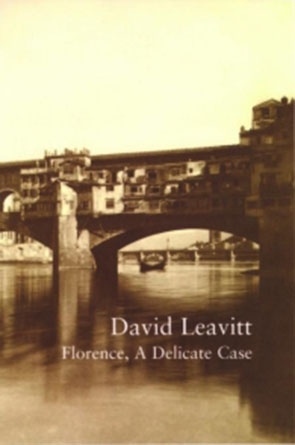At A Different Light bookstore, on Castro Street in San Francisco, I sat beside David Leavitt’s sister—who told me she changed his diapers when he was a baby and that she and her daughter thought David would give them copies of the book that draws on their childhood Palo Alto home and some psychedelic sheets and an earnest young writer who wanted people to listen to his work, refigured as Ben in The Body of Josiah Boyd.
The audience (including me) was entertained by his reading, laughing frequently (his sister particularly loudly). I again noticed he has very large feet. He is tall and a bit stooped from leaning down to shorter people, I imagine. Although wearing a black jacket, he was wearing a striped pink shirt and khakis, not the standard writer total black look.
He said that he had a lot of trouble with perspective in this novel, tried a diary format, third-person, toyed with several first-person narrators before finally realizing that the one with reason to tell the story was Denny (a woman). He also said there were multiple drafts. Words must pour out of him to have multiple drafts and produce books so often!
He also said that he feels he has both a vocation and an obligation to teach, that musicians teach other musicians, and he doesn’t see why writers should not work on craft with students. He also thinks that he writes better when there is something to order the day, saying that he can’t just write all the time, seeing no one. [1]Many have suggested that Leavitt needs to live more, that his experience is very limited; I have complained that he only writes about white, educated, upper-middle-class characters.
After the imbroglio with Stephen Spender and the writer’s block that was partly described and partly resolved “The Term-Paper Artist” (which became the occasion for another imbroglio), Leavitt has continued to churn out stories and novels and anthologies, plus three fairly thin and miscellaneous books dealing with Italy, where he and his partner Mark Mitchell settled. Italian Pleasures and In Maremma were bylined with Mitchell and Florence, A Delicate Case dedicated to him.
The Florence book is not intended to be a guide-book or even a travel book in the sense that Mary McCarthy’s ill-tempered 1959 The Stones of Florence is one. Leavitt, whose admiration for the work of E. M. Forster is obvious across his own oeuvre, set out to write about aliens, mostly Anglophone ones, who took up residence in Florence during the late-19th and early-20th centuries.
Practically the only Florentine in the book is Michelangelo’s statue of David (the difficulty of whose movements Leavitt entertainingly chronicles).
The book is not a systematic history of the English (etc.) colony in Florence but a series of reflections on some of the writers who made extended stays (along with noting that Goethe rushed on for reasons unrevealed) in a city with great art treasures and a very snobbish, very closed elite.
The topic may be unexpected and certainly is narrow, but if one accepts that the topic is not the author’s experience of Florence, or the art and architecture of the city, or a portrait of any native Florentine society; and if the reader can find exiles and long-term visitors of earlier epochs interesting, the book is enjoyable.
I thought there was too much of Harold Acton, portrayed so vividly (and extensively) in James Lord’s luminous Some Remarkable Men, but was interested in the discussions of Scott Moncrieff (the medium through which Proust reached Anglophone readers, including me), Ronald Firbank (all of whose novels I’ve read but about whose life I knew practically nothing), Mikhail Kuzmin (a Russian modernist), Henry James, and (surprising myself) the poetry of the over-precious Osbert Sitwell. There is also an entertaining chapter on the “mud rats,” foreign volunteers who helped retrieve and restore the art and books ravaged by a major 1966 flood.
Leavitt portrays exile among the heavy weight of Renaissance masterpieces as stultifying for many. John Singer Sargent, who I had not known (or had forgotten) was born in Florence, wrote that
The creative artist striving for self-expression must end by feeling oppressed by so much beauty… Where taste is uniformly exquisite, where one is surrounded by masterpieces, one loses initiative in a cloud of wonder. All one’s efforts appear to be dwarfed. One asks oneself: What’s the use?
Sargent was not the only one who found artistic work in Florence difficult. [2]Leavitt’s productivity has been in the Tuscan countryside, and now part of the year in Gainesville, Florida, where he teaches. As Sitwell put it in one of his acidic portraits of fellow expatriates, “killing time is only the name for one of the multifarious ways in which time kills us.”
Light, gossipy, and long on gay content, I found Florence, A Delicate Case providing a pleasant diversion for the two hours it took to read its 166 small pages (mostly in the bookstore and en route to it). Although I can’t imagine how Leavitt concluded that a fifth of the art treasures of the world are in Florence (perhaps a fifth of the Renaissance art treasures of Italy?), I thought he had insightful and/or intriguing things to say about several subjects (mostly other writers). It does have “delicate” in the title, so no one should expect a comprehensive tome.
Florence, A Delicate Case (The Writer and the City)
By David Leavitt
Published by Bloomsbury on June 1, 2002 • 256 pages • Find on Amazon
published on epinions 21 May 2004
©2004, 2016, Stephen O. Murray


